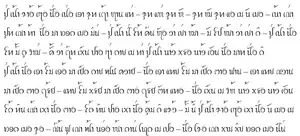Tai Dam language
Tai Dam (Chinese: 傣担语; pinyin: Dǎidānyǔ), also known as Black Tai (Thai: ภาษาไทดำ; pronounced [pʰāːsǎː tʰāj dām]; "Black Tai language"; Chinese: 黑傣语; pinyin: Hēidǎiyǔ), is a Tai language spoken by the Tai Dam in Vietnam, Laos, Thailand, and China (mostly in Jinping Miao, Yao, and Dai Autonomous County).
| Tai Dam | |
|---|---|
| Black Tai | |
| ꪼꪕꪒꪾ; ไทดำ | |
| Native to | Vietnam, Laos, Thailand, China |
| Ethnicity | Tai Dam |
Native speakers | (760,000 cited 1995–2002)[1] |
Kra–Dai
| |
| Tai Viet | |
| Official status | |
Recognised minority language in | |
| Language codes | |
| ISO 639-3 | blt |
| Glottolog | taid1247 |
The Tai Dam language is similar to Thai and Lao, but it is not close enough to be readily understood by most Thai and Lao speakers. In particular, the Pali and Sanskrit additions to Thai and Lao are largely missing from Tai Dam.[2]
Geographical distribution
Tai Dam is spoken in Vietnam, China, Laos, and Thailand. In central Thailand, it is known as Thai Song.
Tai Dam speakers in China are classified as part of the Dai nationality along with almost all the other Tai peoples. But in Vietnam they are given their own nationality (with the White Tai) where they are classified (confusingly for English speakers) as the Thái nationality (meaning Tai people).
In China, Tai Dam (Chinese: 傣朗姆) people are located in the following townships of Yunnan, with about 20,000 people in Yunnan (Gao 1999).[3]
- Maguan County 马关县: Muchang Township 木厂乡, Dalishu Township 大栗树乡, and Pojiao Township 坡脚乡
- Wenshan County 文山县: Dehou Township 德厚乡, Panzhihua Township 攀枝花乡
- Hekou County 河口县: Qiaotou Town 桥头镇 (in Baihei Village 白黑村 and Gantianzhai 甘田寨)
- Yuanjiang County 元江县: Dashuiping Township 大水平乡 (in Gaozhai 高寨 and Yangmahe 养马河)
Official status
In Vietnam, all Tai peoples are taught a standardized Tai language based on the Tai Dam language, using the standardized Tai Viet script.[4]
Phonology
Initials
| Labial | Alveolar | Palatal | Velar | Glottal | |||
|---|---|---|---|---|---|---|---|
| plain | lab. | ||||||
| Plosive | tenuis | [p] | [t] | [k] | [kʷ] | [ʔ] | |
| aspirated | [tʰ] | ||||||
| voiced | [b] | [d] | |||||
| Affricate | [t͡ɕ] | ||||||
| Nasal | [m] | [n] | [ɲ] | [ŋ] | [ŋʷ] | ||
| Fricative | voiceless | [f] | [s] | [x] | [xʷ] | [h] | |
| voiced | [v] | ||||||
| Approximant | [l] | [j] | |||||
- Sounds /b/ and /d/ can fluctuate to voiced implosive sounds [ɓ], [ɗ]. /d/ may also fluctuate to a lateral sound [l]. /v/ can fluctuate to sounds [b~ɓ].
- In some rare cases /j/ can be realized as a [z] sound.
Writing system

The Tai Dam language has its own system of writing, called Tai Viet, which consists of 31 consonants and 14 vowels. Although the language is tonal, there are no tone markers, as there are in Thai and Lao. According to Thai authors, the writing system is probably derived from the old Thai writing of the kingdom of Sukhotai.[2]
Further reading
References
- Tai Dam at Ethnologue (18th ed., 2015)
- Bankston, Carl L. "The Tai Dam: Refugees from Vietnam and Laos". Passage: A Journal of Refugee Education. 3 (Winter 1987): 30–31.
- Gao Lishi 高立士. 1999. 傣族支系探微. 中南民族学院学报 (哲学社会科学版). 1999 年第1 期 (总第96 期).
- Choowonglert, Achariya (2015). "We Do Not Want to be Inferior: Politics of Difference in Teaching and Studying Tai Languages in North-Central of Vietnam". Cite journal requires
|journal=(help) - Fippinger, Jay W. and Dorothy C. (1970). Black Tai Phonemes, with Reference to White Tai. Anthropological Linguistics.